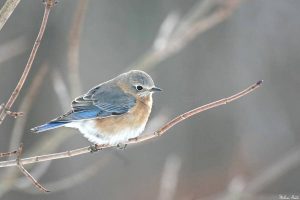 The Eastern Bluebird is among the many grassland and shrubland birds found at Badger Army Ammunition Plant. Two successful bluebird trails with more than 80 houses are carefully maintained and monitored by members of the Bluebird Restoration Association of Wisconsin. Every week, beginning in early spring, these dedicated volunteers carefully record the number of eggs, hatches, and fledglings. Photograph by Melissa Penta.
The Eastern Bluebird is among the many grassland and shrubland birds found at Badger Army Ammunition Plant. Two successful bluebird trails with more than 80 houses are carefully maintained and monitored by members of the Bluebird Restoration Association of Wisconsin. Every week, beginning in early spring, these dedicated volunteers carefully record the number of eggs, hatches, and fledglings. Photograph by Melissa Penta.
Wisconsin ranks second nationally in the proportion of citizens considered birders, with fully one-third of residents 16 and older reporting they travel to watch birds, or actively watch and identify birds around home, according to a recently released U.S. Fish & Wildlife Service report.
Wisconsin trailed only Vermont, where 39 percent of residents are birders, and tied with West Virginia, where 33 percent of their population also watches birds. Numbers-wise, however, the Badger State vastly outnumbered those two states, with Wisconsin boasting 1,678,000 birders, compared to 292,000 for the Green Mountain State and 574,000 for the Mountain State.
“Wisconsin is well known for its rich tradition of birding and other forms of wildlife watching,” says Ryan Brady, Wisconsin Bird Conservation Initiative monitoring coordinator and Department of Natural Resources research scientist. “Here we have a strong connection to our natural resources, and their vibrant colors, soothing songs, and high degree of visibility make birds a crowd favorite.”
Wisconsin features both northern and southern breeding species and sits astride a major migration pathway, allowing birders easy access to one of the most diverse collections of bird life in the United States. More than 400 species have been recorded in the state, with the vast majority of species and numbers being migratory birds. Others, like chickadees, cardinals, grouse, and turkeys, are permanent residents
Brady says spectacles such as staging sandhill cranes, waterfowl migration on the Mississippi River, goose migration at Horicon Marsh, booming prairie chickens, overwintering bald eagles, and more than 30 species of warblers are some of the state’s biggest birding draws.
Nationally, there were about 47 million birders, about 20 percent of the population 16 and older, according to the report. They spent an estimated $41 billion on trip related expenditures and equipment, generated a total economic impact of $106 billion, supported 666,000 jobs and generated $13 billion in state and federal tax revenues.
Kim Grveles, who coordinates Wisconsin’s Bird Stopover Initiative, says the keen interest in birding in Wisconsin can be seen in the growing number of communities seeking “Bird City Wisconsin” status indicating their commitment to bird conservation efforts. Since the program started in 2010, 76 communities have been designated Bird Cities including several adjacent to the Badger Army Ammunition Plant.
“There’s a growing recognition of what’s needed to maintain healthy populations of birds and to understand birds’ importance to their economies and quality of life,” Grveles says. “The national survey’s participation rates and economic rates reflect the important role birds play for our local communities and our state.”
You can help save the Songs of Badger…
Sign our petition to WDNR at http://cswab.org/get-involved/alerts/
This is the final in our five part series on songbirds. More informational series are planned, so stay tuned!
References:
- Wisconsin Department of Natural Resources, National survey: Wisconsin ranks second in bird watching, February 25, 2014.
- Wisconsin Department of Natural Resources, Regional & Property Analysis: Sauk Prairie Recreation Area, July 2012.
- Wisconsin’s Natural Heritage Inventory Program, Bureau of Endangered Resources, Rapid Ecological Assessment for the Sauk Prairie Recreation Area, December 2011.

